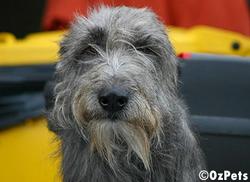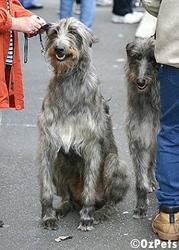
|



|
| DEERHOUND |

|
 |
|
History
The Deerhound has played an important part in the development of this country and it is undoubtedly true that it is one of, if not the oldest breed of British dog - Here, in the early days it was in demand as a companion and as a supplier of food.
Later, as the pastoralists moved further west with their flocks and the rabbit, fox and dingo became the scourge of the countryside, there was a demand for a dog with strength, speed and stamina. What better breed than the Deerhound? Frequently, they were used as station sires and the Kangaroo Dog developed.
After the gold rush when the wool industry was well established there was an interest in purebred stock and agricultural and kennel societies were formed and Deerhounds began to appear on the show bench. Wealthy squatters even established their own deer parks. The McConnels of Cressbrook, Queensland, imported Deerhounds and introduced deer to the Brisbane Ranges in the late 1870's. Robert Christison of Hughenden, one. of the pioneers of .the frozen meat industry, imported a pair in 1892. The Winter-Irvings, David Syme and the Chirnsides, all owned and showed Deerhounds, and the Chirnsides had their own deer park in the area now known as Deer Park. Sam Horden, President of the RAS (NSW) imported a number including Fair Catherine of Abbotsford and bred them under the Retford prefix
After the First World War until well into the thirties times were hard in the countryside and for a while it seemed that the purebred dog in Australia could well face extinction. It was about this time that Donald Thomson imported a number from New Zealand where they were used for hunting red deer and the breed, did survive. These were a strain of sandy-wheaten dogs.
Shortly after the war Doug Mummery, John Gorman and Noel Wettenhall, imported stock from Britain, and by the 1950's and 60's, 25 point challenges were common at the Melbourne Royal.
Today our dogs and/or their descendants are to be found in New Zealand, New Caledonia, the United States and Britain. |

|
Overview
The Deerhound is a very large aristocratic breed that resembles a rough coated Greyhound of larger size and bone. His hunting origins have shaped his form to a perfect combination of speed, agility, and courage. They may not be suited to everyone as they need a large space, regular exercise and have a hearty appetite. They are a faithful companion, very courageous and though sometimes wary of strangers are unlikely to bark and growl when someone approaches the front door rather meet them with a long sniff. They are an extremely dignified, sensitive and gentle dog.
The adult Deerhound is prone to laziness, though this is obviously not good for them and they should be regularly exercised. The lifespan of the Deerhound is on average about 9 years for bitches and 8 years for males. Deerhounds have the usual large breed health problems but not to the extent of the other large breeds.
They have a harsh wiry coat about 7-10 cm long, it is softer on the head, belly, and breast. The coat requires minimal grooming but it does shed. The colourings of the Deerhound are a dark blue/grey, dark or lighter greys and brindles with black points.
Deerhounds have a hunting origin so must be socialised as a puppy in order to introduce them properly to other small animals. Deerhounds are generally great with children though they are not a dog to be roughed and tumbled with.
In summary an amazing dog, but only a lifestyle suited to extensive exercise will suit as the Deerhound is almost impossible to tire on a walk.
Housing
Deerhounds are a wonderful companion dog, preferring human company as often as possible. Whatever you are doing, they like to be with you and fit in well with your life considering their size. Deerhounds seem to have an inbuilt instinct on where to find all the comfortable spots in the house and make very good in-door dogs if permitted. However, if they are to remain outdoor dogs, a cosy, warm kennel, shed or suitable place needs to be provided for your dog, free from draughts with a warm blanket or piece of carpet for a bed. |

|
 |
|
This should not' be too far from the house as Deerhounds like to be close to the family and will feel rejected if banished to the far end of the yard. Sunshine, light and a shaded area are most important considerations for the healthy growing pup and a secure fenced yard must be provided as Deerhounds have almost no road sense and think traffic has to stop for THEM. Be prepared to see your growing pup jump over the metre high fence you carefully built for him last month!
Most Deerhounds like to jump and think nothing of clearing the average garden fence or even higher. So be warned. Your new puppy will be quite upset initially , being away from the rest of the litter for the first time, so for the first few nights the warmth of a hot water bottle wrapped in a towel can provide security and comfort until he adjusts to his new surroundings .
Female deerhounds rarely have their first to season it or "heat" before the age of 8-10 months. Sometimes not until they are 2 years old or more, so don't worry if there is no sign at 6 months as in smaller breeds. Of course she must be confined in a secured yard for the duration of the heat which can vary but usually lasts 21 days.
Feeding
Correct feeding is most important while the pup is growing, so he needs a balanced diet. This can be given in the form of a good quality commercial dry puppy food. For example, Harpers Puppy Chow or Lucky Puppy, made available all day in dry form when the pup is older and able to chew, or softened in hot water with milk added, given 2 or 3 times a day up to the age of 3 months or so. This forms a good diet basis for a developing pup. Moist food should not be left uneaten for more than a couple of hours as it goes off and attracts flies. If you can't replace uneaten food due to your absence during the day, leave only dry food, which should be available to the pup at all times. Puppies rarely overeat, so leaving food available all day is usually the best arrangement.
The addition of fresh meat is an advantage and most breeders feel it is an essential part of a dogs diet. An egg given 2 or 3 times a week also is of benefit as added protein and aids in- a glossy coat. Where eggs are plentiful more may be given, consult your vet if you are not sure.
The following are examples of a days feeding firstly for young pups up to 12 or 16 weeks of age then for older pups to 12 or 15 months. |

|
| Up to 4 Months: | | Early Morning : | A form of cereal plus milk, e.g. weetbix, Vitabrits, bread,etc.
| | Midday : | Softened puppy chow in milk | | Late Afternoon : | Milk, fresh meat, chopped, plus puppy chow all mixed with an egg occasionally, or fed separately (all pups are different, see what he prefers).
| Up to 15 months
| | Morning : | Puppy Chow moist or dry depending on pups preference | | Evening : | Chopped fresh meat plus Puppy Chow and occasionally an egg added | | Water must be made available at all times for all ages. | | Additives : | If the basis of the diet is Puppy Chow or similar it is not really necessary to add vitamin supplements, but it is essential to large breeds such as the Deerhound to have additional calcium every day, either in the form of
Calcium Carbonate, I to 2 teaspoons per day, or Calcium Gluconate at the recommended dose.
|
|

|

|

|
| Deerhound Club of Victoria |
| Tel : 03 9719 7277 |

|
|
| Last Update: 27/03/07 16:31 |
Views: 5901 |
|

|